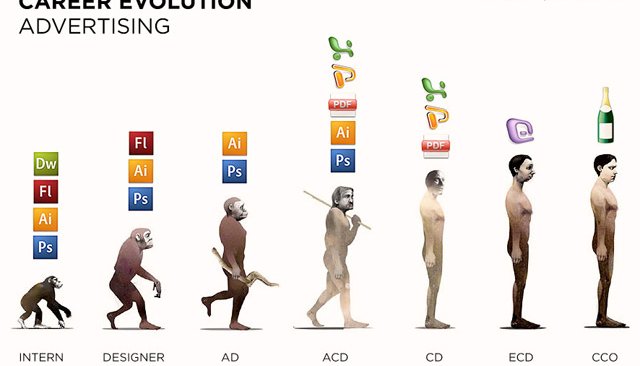The Evolving Role of Design
The role of design evolves at the speed of innovation—the dizzying, dynamic speed of the market. Design now has a seat at executive and board tables across the globe. More than ever, a holistic sense of design is valued as a legal means of significant competitive advantage.
But it hasn’t always been this way. The journey from the cubicle to the corner office to the open office began with the scope of what was being designed and the role design played within organizations.
Design started with designing things, objects, and then expanded to the graphics, packaging and advertising. Now, designers—not necessarily decorators—help design spaces, experiences, innovations and business models.
If you look at the world of organizational management you’ll see this same progression: First, the species learned how to manage things, then time, now energy.

Because business, the world of nonprofits, and the market are all so quickly transforming, they need designers to help craft meaning, purpose and inspiration, as well as to optimize overall gestalt—from signs to things to space to experiences.
Design is beginning to drive business needs, instead of the other way around, and that’s a positive move.
Remember what happens when design stays subservient to business needs?
Look at any mass store—Wal-Mart, Target, Walgreens, any grocery store—and you’ll see the precarious quagmire that happens when design is subservient to business needs. So much waste is created. So many me-too products fail—95 out of 100, in fact.
When design is on the product-attribute level without fresh consumer insights (not even on the brand level, or the business level, or on the social level yet), a glut gets created with too many things that we will not consume and that will surfeit landfills across the globe. Why bother?
But if you start by creating a problem for a real human need, you craft a solution, and isn’t this urge at the heart of the design process: to make something that is beautiful both functionally and aesthetically?
So, now that design has a voice at the decision table, how can we better decide what to create? By widening the scope of design to include human factors, consumer or customer insights, and by understanding the context deeply before deciding what problem to fix.
In other words, by scanning the landscape door-to-door and being willing to challenge all organizational orthodoxies: the business model, the channel strategy, the brand elasticity, everything.
Of course there is a paradox at play. Once you design a business model and begin to craft at the experience level, then you have more freedom to design better artifacts and interiors at all with a holistic design world. Think of it as a meta-design.
The emerging role of the designer makes it imperative that you zoom out to the widest perspective of possibilities and then zoom back into the details that conjure an irrepressible world unto itself.
We are talking about Big Design, Big D, Meta D. Designing the energetics, level of interaction, the culture of work, and the methods of inquiry, creation and production—the invisible infrastructure of how all pieces and parts of an organization and the world interrelate.
Let’s call the role the creator and keeper of the golden thread of experience alignment. Others call it “the designful company,†but that speaks only about the method and doesn’t convey the value of the method. Conscious and continual renewal is the objective.
Corporations have learned that the futurist Alvin Toffler was correct: You can analyze the past but must design your future. This is the level of design that matters, Big D. We cannot create a better world by doing what worked well in the past more forcibly.
More than ever, there are economic, ecological and socio-cultural reasons to apply this type of design in organizations.
With the hiring of Ernesto Quinteros as Johnson & Johnson’s first chief design officer (CDO), we see a growing acknowledgement that old-line companies value Big D by elevating the role of design throughout the enterprise. PepsiCo, Philips and many others have this C-suite role.
A Forbes piece notes that “the idea of design is being baked into every aspect of corporate life . . . The new title also reflects the dawning of a new outlook on what companies produce and their dynamic relationships with customers. It is the well-designed products and services offering new experiences that are captivating consumers’ attention.â€
Such design leaders align experiences inside and outside the company and also help that intersection of inner and outer blur to the point of insight. From the same piece: “The CDO has a unique combination of skills that help businesses understand and engage consumers in a more holistic way. Designers better understand the needs and wants of consumers that allow them to be able to better identify and create new products and services.â€
Fast Company noted this position as The Job of the Future. As Yves Béhar keenly points out: “CDO will be a job in every company, overseeing the design of a business’s every touchpoint . . . Designers are no longer being brought in at the end of the process to make things look pretty, but rather are providing essential insights from the ground up.â€
Corporate cultures’ attitudes toward design have shifted. Visa, PayPal and other leading financial companies have design integrated into their service capabilities and leadership teams. Venture capitalists and private equity firms often insist on infusing their portfolio companies with design at every level of the business.
This paradigm shift for the field of design marks a significant transformation of the roles, skill sets and scope of the practice of design. Design has never been more highly valued as an economic and social force.
Big design is here to stay, and to craft our shared future. Embrace it or get out of the way.
Wait! Before you go.
Choose how you want the latest innovation content delivered to you:
- Daily — RSS Feed — Email — Twitter — Facebook — Linkedin Today
- Weekly — Email Newsletter — Free Magazine — Linkedin Group
 Michael Graber is the co-founder and managing partner at Southern Growth Studio, a Memphis, Tennessee-based firm that specializes in growth strategy and innovation. A published poet and musician, Graber is the creative force that complements the analytical side of the house. He speaks and publishes frequently on best practices in design thinking, business strategy, and innovation and earned an MFA from the University of Memphis. Follow Michael @SouthernGrowth
Michael Graber is the co-founder and managing partner at Southern Growth Studio, a Memphis, Tennessee-based firm that specializes in growth strategy and innovation. A published poet and musician, Graber is the creative force that complements the analytical side of the house. He speaks and publishes frequently on best practices in design thinking, business strategy, and innovation and earned an MFA from the University of Memphis. Follow Michael @SouthernGrowth
NEVER MISS ANOTHER NEWSLETTER!
LATEST BLOGS
Four ways you can ensure employees take accountability for their work
One of the most important driving factors for any successful business is a high-performing team. Having people working for you…
Read MoreWhat is digital upskilling and why is it important?
Photo by Annie Spratt on Unsplash In a world of business that never stands…
Read More


